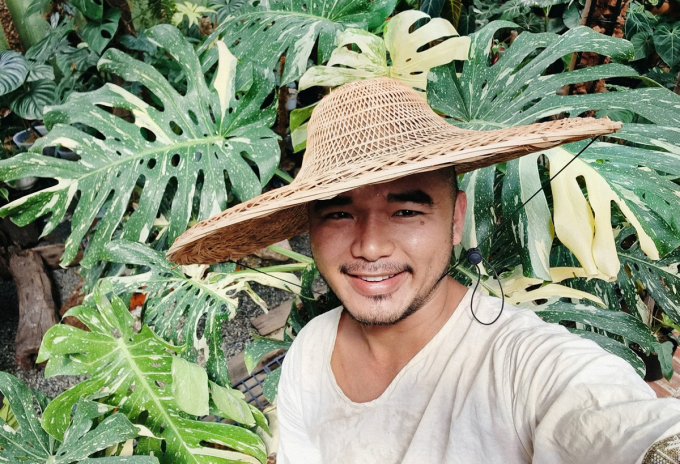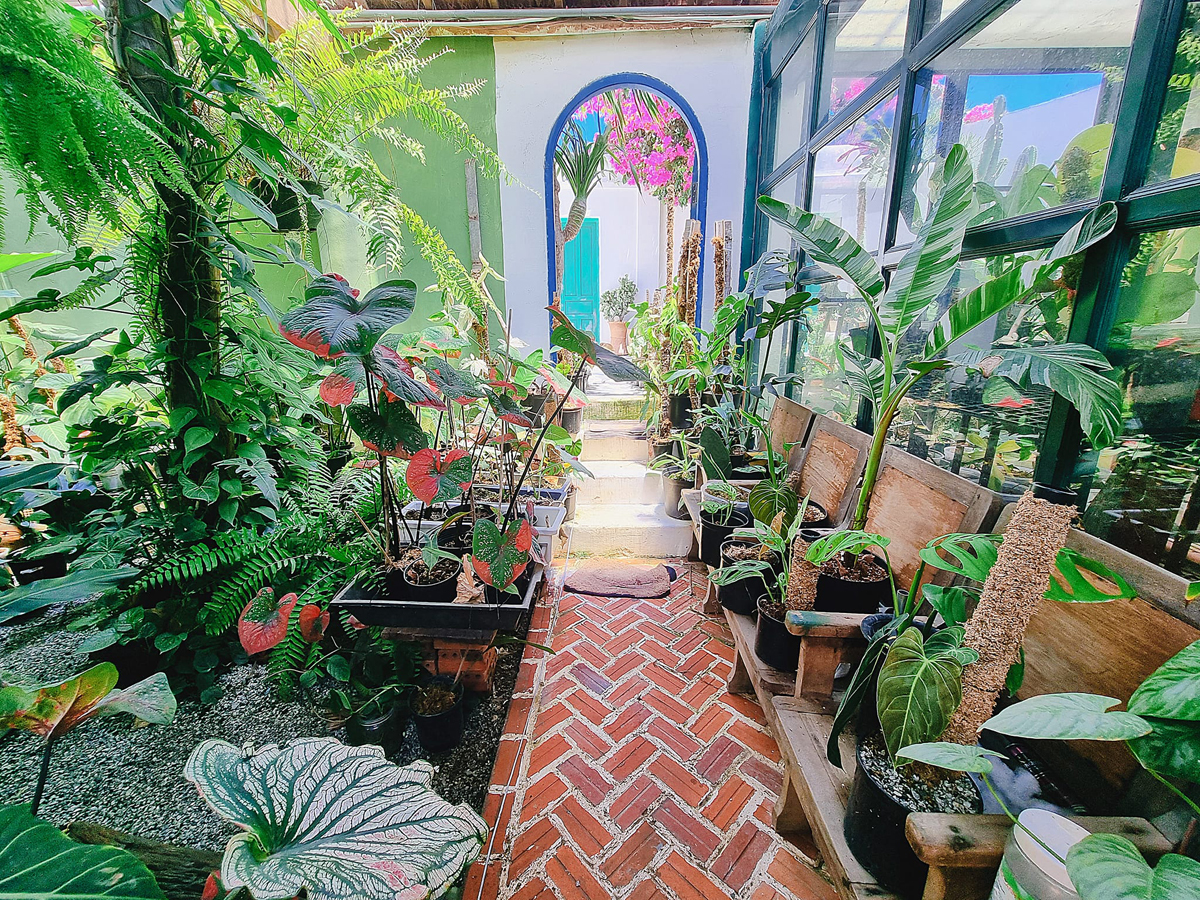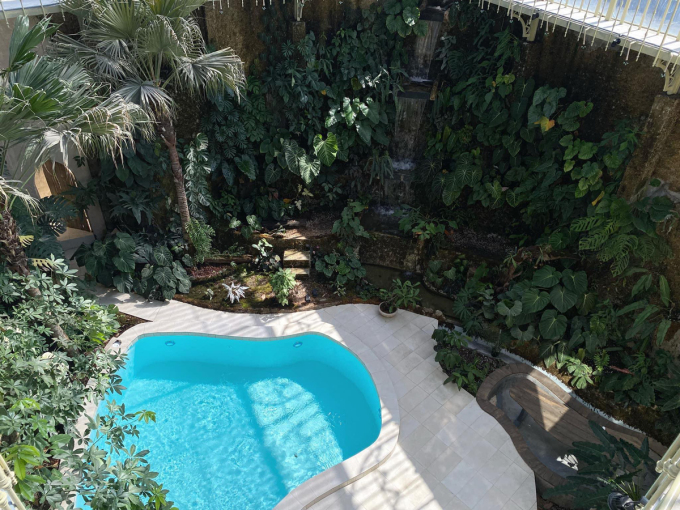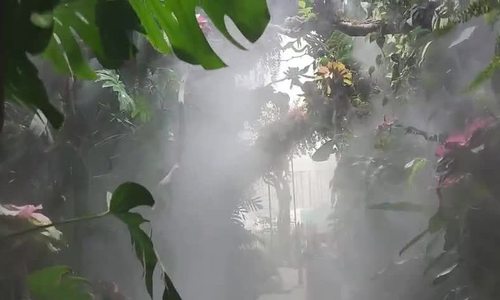People are spending hundreds of millions of dong to transform their houses into indoor tropical forests.
Every morning, in the coastal Phan Rang Town in the central province of Ninh Thuan, a humidification system automatically sprays mist on Phu Tue Tri’s indoor garden.
Banana trees, white and pink anthuriums, long and wide betel leaves, vines, ferns, and others, bathed in morning mist and sunlight give the impression of a mini forest.
 |
|
Phu Tue Tri poses for a photo with his plants at his home in Ninh Thuan Province in March, 2022. Photo courtesy of Tri |
“The first thing I do in the morning is take a good look at my garden, the 35-year-old photographer says.
“The best part is when I see a plant sprouting new leaves”.
The plant enthusiast has traveled to mountains and forests in Vietnam and around the world but since Covid-19 broke out all his traveling plans have come to a halt.
While cooped up at home, he came across an online community of house plant enthusiasts and joined the home gardening trend.
“Initially I intended to grow monstera deliciosa, which is a plant that every plant lover wishes to own. Then I started wanting more plants in various different colors”.
When he relocated to HCMC in June last year, he set up a gardening area in his renovated fourth-floor home to grow more indoor plants.
He has lost count of how many plants he currently has but “my house looks exactly like a forest,” he says.
 |
|
Tri’s indoor garden. Photo courtesy of Tri |
Dinh Han’s indoor garden also in Phan Rang Town also resembles a jungle. The 170-square-meter area is filled with plants that are a few meters tall or leafy ornamental plants covering the entire wall, and has the constant sounds of birds chirping.
Han is a well-known landscaper with a collection of plants estimated to be worth multi-billion dong.
He decided to create a tropical jungle with his unique potted plants when he built his house over a year ago.
For eight months the 29-year-old tinkered with ideas and planted them all himself. When it was finished, his garden stunned the communities of plant lovers.
 |
|
A view from above of Dinh Han’s indoor garden. Photo courtesy of Dinh Han |
Will Tran, a 37-year-old interior designer in HCMC, has even taken the jungle into his bedroom.
“I want to see plants every morning when I wake up,” he says.
He divided a 10-square-meter bedroom into two zones and grew platycerium and philodendron vines on the wall at the head of the bed to absorb the afternoon sun.
The area at the bottom of the bed is dedicated to plants like anthurium and monsteria and is set up in a tiered layout to allow the plants enough room to grow. Because there is little sunshine inside he installed a light and a humidifier.
He says people often wonder if he asphyxiates while sleeping since trees normally breathe out carbon dioxide at night.
“In the bedroom, I grow plant species that have reverse photosynthesis and absorb CO2 and release oxygen at night.
“Tiger tongue is one of them.”
He does, however, recommend that people should choose small plants and keep them at least two meters away from the bed. He also tells people to open the window at night if the weather is cool or use an air conditioner to filter the air.
In the last year or so there has been a trend among young people in major cities of filling their homes with plants.
“The tropical styled home mimics the layers of the Amazon jungle by mixing tall, mid-range and low plants, creepers, shrubs, drooping plants, vines, moss, and others,” The Vuong, founder of a landscaping company in HCMC, explains.
Though making its way into Vietnam not too long ago, it has quickly gained popularity and accounts for around 20 percent of Vuong’s work.
He has created indoor tropical forests for dozens of households in the past year, and the one he is most proud of is in District 2.
Looking at photos or videos online of the house, one might think it is a coffee shop, but it is actually a private house.
Landscapist The Vuong’s indoor jungle in a house in HCMC’s District 2. Video acquired by VnExpress
In the corridors of the apartment, the property owner has a forest that is 12 meters long and over six meters high. It has hundreds of plant species growing in layers, helping create a deep jungle ambience.
The plants alone cost several hundreds of millions of dong (VND100 million = $4,350).
According to HCMC architect Nguyen Ba Thieu, the burgeoning land prices make owning an outdoor garden prohibitively expensive.
But people are staying at home more as a result of the pandemic and are more concerned with their living space, and so are setting up greenery inside their houses.
Every year Thieu is commissioned to set up around 10 indoor rainforests.
In Vietnam, tropical forest-style gardens often have ornamental species, South American pineapples, moss, orchids, and ferns, which are both beautiful and not too expensive.
“A garden of 20-30 square meters costs around VND40 million if one grows common plant species, but the cost is much higher with exotic plants,” Thieu explains.
Many houses now have a few areas inside for plants, particularly of the ornamental kind, which do not require a lot of light, purify the air and add a classy touch to a property.
“This is and will be the trend when people want to bring as much nature into their living space as possible,” Thieu says.
Tri, Dinh, Loi and Phat will opt to grow their own ornamental species because it is also a way to protect the environment by avoiding the exploitation of plants in nature.
- Reduce Hair Loss with PURA D’OR Gold Label Shampoo
- Castor Oil Has Made a “Huge” Difference With Hair and Brow Growth
- Excessive hair loss in men: Signs of illness that cannot be subjective
- Dịch Vụ SEO Website ở Los Angeles, CA: đưa trang web doanh nghiệp bạn lên top Google
- Nails Salon Sierra Madre
 VnExpress News The News Gateway of Vietnam
VnExpress News The News Gateway of Vietnam






